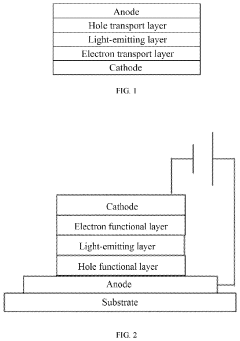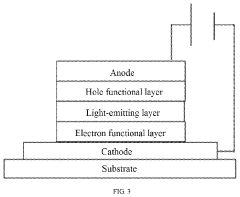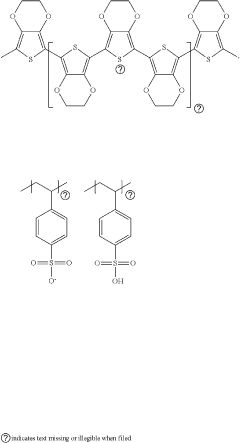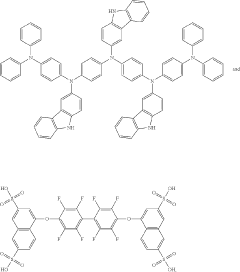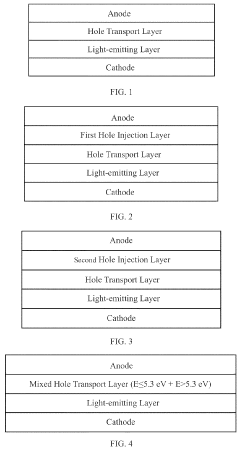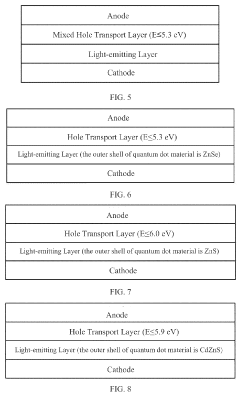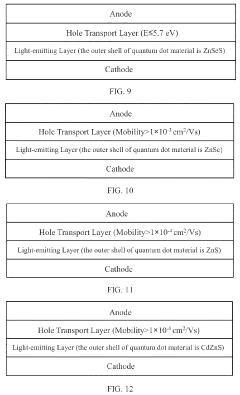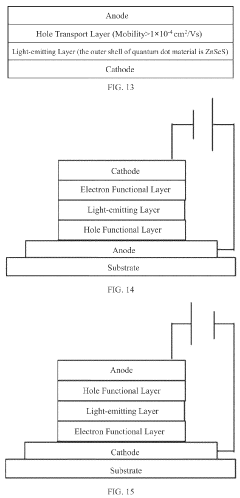Future‑Proofing QLED Technology: Industry Insights
JUN 20, 20259 MIN READ
Generate Your Research Report Instantly with AI Agent
Patsnap Eureka helps you evaluate technical feasibility & market potential.
QLED Evolution and Objectives
Quantum Dot Light-Emitting Diode (QLED) technology has emerged as a revolutionary advancement in display technology, offering superior color performance and energy efficiency compared to traditional LED displays. The evolution of QLED technology can be traced back to the early 2000s when researchers first began exploring the potential of quantum dots in display applications. Since then, QLED has undergone significant improvements in terms of color accuracy, brightness, and longevity.
The primary objective of QLED technology is to provide an enhanced viewing experience by leveraging the unique properties of quantum dots. These nanoscale semiconductor particles emit light of specific wavelengths when excited, allowing for precise color control and a wider color gamut. As the technology has progressed, manufacturers have focused on improving quantum dot efficiency, stability, and manufacturing processes to make QLED displays more commercially viable.
In recent years, the QLED market has seen rapid growth, with major players like Samsung, TCL, and Vizio adopting the technology in their high-end television and monitor lineups. The increasing demand for high-quality displays in various sectors, including consumer electronics, gaming, and professional applications, has driven further innovation in QLED technology.
Looking ahead, the future objectives for QLED technology are multifaceted. One key goal is to enhance the energy efficiency of QLED displays, reducing power consumption while maintaining or improving picture quality. This aligns with global efforts to create more sustainable consumer electronics. Another important objective is to extend the lifespan of QLED displays, addressing concerns about the long-term stability of quantum dots.
Researchers and manufacturers are also exploring ways to improve the color volume and peak brightness of QLED displays, aiming to surpass the capabilities of OLED technology in these areas. Additionally, there is a focus on developing more cost-effective production methods to make QLED technology accessible to a broader range of consumers.
As the display industry continues to evolve, QLED technology faces competition from emerging technologies such as microLED. To remain competitive, QLED developers are investigating hybrid approaches that combine quantum dots with other display technologies to leverage the strengths of each. The ultimate goal is to create displays that offer unparalleled visual quality, energy efficiency, and durability, cementing QLED's position as a leading display technology for the foreseeable future.
The primary objective of QLED technology is to provide an enhanced viewing experience by leveraging the unique properties of quantum dots. These nanoscale semiconductor particles emit light of specific wavelengths when excited, allowing for precise color control and a wider color gamut. As the technology has progressed, manufacturers have focused on improving quantum dot efficiency, stability, and manufacturing processes to make QLED displays more commercially viable.
In recent years, the QLED market has seen rapid growth, with major players like Samsung, TCL, and Vizio adopting the technology in their high-end television and monitor lineups. The increasing demand for high-quality displays in various sectors, including consumer electronics, gaming, and professional applications, has driven further innovation in QLED technology.
Looking ahead, the future objectives for QLED technology are multifaceted. One key goal is to enhance the energy efficiency of QLED displays, reducing power consumption while maintaining or improving picture quality. This aligns with global efforts to create more sustainable consumer electronics. Another important objective is to extend the lifespan of QLED displays, addressing concerns about the long-term stability of quantum dots.
Researchers and manufacturers are also exploring ways to improve the color volume and peak brightness of QLED displays, aiming to surpass the capabilities of OLED technology in these areas. Additionally, there is a focus on developing more cost-effective production methods to make QLED technology accessible to a broader range of consumers.
As the display industry continues to evolve, QLED technology faces competition from emerging technologies such as microLED. To remain competitive, QLED developers are investigating hybrid approaches that combine quantum dots with other display technologies to leverage the strengths of each. The ultimate goal is to create displays that offer unparalleled visual quality, energy efficiency, and durability, cementing QLED's position as a leading display technology for the foreseeable future.
QLED Market Dynamics
The QLED market has experienced significant growth in recent years, driven by increasing demand for high-quality display technologies across various sectors. As consumers seek superior visual experiences, QLED technology has emerged as a formidable competitor to OLED and traditional LCD displays. The market dynamics of QLED are characterized by rapid technological advancements, shifting consumer preferences, and evolving competitive landscapes.
One of the primary factors fueling QLED market growth is the technology's ability to deliver vibrant colors, high brightness levels, and improved energy efficiency compared to conventional display technologies. This has led to widespread adoption in premium television sets, with major manufacturers like Samsung, TCL, and Hisense heavily investing in QLED development and production.
The market has also seen expansion beyond the television segment, with QLED technology making inroads into monitors, digital signage, and automotive displays. This diversification has opened up new revenue streams and opportunities for market players, contributing to the overall growth of the QLED ecosystem.
Consumer demand for larger screen sizes and higher resolutions has been a key driver in the QLED market. As 4K and 8K content becomes more prevalent, QLED displays are well-positioned to meet the requirements for enhanced picture quality and color accuracy. This trend is expected to continue, with manufacturers focusing on developing larger QLED panels with even higher resolutions.
The competitive landscape of the QLED market is dynamic, with several key players vying for market share. Samsung Electronics has maintained a dominant position, leveraging its early investments in QLED technology. However, other manufacturers are rapidly catching up, introducing their own QLED products and driving innovation in the field.
Price competition has become increasingly intense as more players enter the market and production efficiencies improve. This has led to a gradual decrease in the average selling price of QLED displays, making the technology more accessible to a broader range of consumers. However, premium QLED products continue to command higher prices, particularly in the high-end television segment.
Regional market dynamics play a crucial role in QLED adoption. North America and Europe have been early adopters of QLED technology, driven by high disposable incomes and consumer demand for cutting-edge display technologies. The Asia-Pacific region, particularly China, has emerged as a significant growth market, with local manufacturers ramping up QLED production and driving market expansion.
Looking ahead, the QLED market is poised for continued growth, with technological advancements and increasing applications driving demand. The development of next-generation QLED technologies, such as micro-LED and nano-LED, is expected to further enhance display performance and open up new market opportunities. As the technology matures and production costs decrease, QLED displays are likely to penetrate mid-range product segments, expanding their market reach and solidifying their position in the global display industry.
One of the primary factors fueling QLED market growth is the technology's ability to deliver vibrant colors, high brightness levels, and improved energy efficiency compared to conventional display technologies. This has led to widespread adoption in premium television sets, with major manufacturers like Samsung, TCL, and Hisense heavily investing in QLED development and production.
The market has also seen expansion beyond the television segment, with QLED technology making inroads into monitors, digital signage, and automotive displays. This diversification has opened up new revenue streams and opportunities for market players, contributing to the overall growth of the QLED ecosystem.
Consumer demand for larger screen sizes and higher resolutions has been a key driver in the QLED market. As 4K and 8K content becomes more prevalent, QLED displays are well-positioned to meet the requirements for enhanced picture quality and color accuracy. This trend is expected to continue, with manufacturers focusing on developing larger QLED panels with even higher resolutions.
The competitive landscape of the QLED market is dynamic, with several key players vying for market share. Samsung Electronics has maintained a dominant position, leveraging its early investments in QLED technology. However, other manufacturers are rapidly catching up, introducing their own QLED products and driving innovation in the field.
Price competition has become increasingly intense as more players enter the market and production efficiencies improve. This has led to a gradual decrease in the average selling price of QLED displays, making the technology more accessible to a broader range of consumers. However, premium QLED products continue to command higher prices, particularly in the high-end television segment.
Regional market dynamics play a crucial role in QLED adoption. North America and Europe have been early adopters of QLED technology, driven by high disposable incomes and consumer demand for cutting-edge display technologies. The Asia-Pacific region, particularly China, has emerged as a significant growth market, with local manufacturers ramping up QLED production and driving market expansion.
Looking ahead, the QLED market is poised for continued growth, with technological advancements and increasing applications driving demand. The development of next-generation QLED technologies, such as micro-LED and nano-LED, is expected to further enhance display performance and open up new market opportunities. As the technology matures and production costs decrease, QLED displays are likely to penetrate mid-range product segments, expanding their market reach and solidifying their position in the global display industry.
QLED Tech Challenges
QLED technology, while promising, faces several significant challenges that need to be addressed to ensure its long-term viability and competitiveness in the display market. One of the primary hurdles is the issue of blue light degradation. The blue quantum dots used in QLED displays tend to degrade faster than their red and green counterparts, leading to color shift and reduced lifespan of the display. This problem is particularly acute in high-brightness applications and needs innovative solutions to maintain color accuracy over time.
Another major challenge is the efficiency of quantum dot light conversion. While QLEDs offer improved color gamut compared to traditional LED-LCD displays, there is still room for improvement in terms of energy efficiency. The conversion process from blue light to other colors through quantum dots results in some energy loss, which impacts the overall power consumption of QLED devices. Enhancing the quantum yield of quantum dots and optimizing the light management within the display structure are crucial areas for advancement.
Manufacturing scalability and cost-effectiveness present additional obstacles. The production of high-quality quantum dots with consistent size and properties at industrial scales remains challenging. Variations in quantum dot size can lead to color inconsistencies across the display, affecting overall image quality. Moreover, the current manufacturing processes for quantum dots are relatively expensive, which impacts the final cost of QLED products. Developing more efficient and cost-effective production methods is essential for wider market adoption.
Environmental concerns and regulatory compliance also pose challenges for QLED technology. Some quantum dot materials contain heavy metals like cadmium, which are subject to strict regulations in many countries due to their potential environmental and health impacts. While cadmium-free alternatives are being developed, they often do not match the performance of cadmium-based quantum dots. Balancing performance with environmental sustainability is a critical challenge that the industry must address.
Lastly, the integration of quantum dots into flexible and foldable display technologies presents a significant technical hurdle. As the display market moves towards more versatile form factors, QLED technology must adapt to maintain its relevance. Developing quantum dot materials and encapsulation techniques that can withstand the mechanical stress of flexible displays without compromising performance or lifespan is a complex challenge that requires innovative solutions.
Addressing these challenges will be crucial for the future-proofing of QLED technology. It will require concerted efforts in materials science, manufacturing processes, and display engineering to overcome these obstacles and fully realize the potential of QLED displays in the evolving consumer electronics landscape.
Another major challenge is the efficiency of quantum dot light conversion. While QLEDs offer improved color gamut compared to traditional LED-LCD displays, there is still room for improvement in terms of energy efficiency. The conversion process from blue light to other colors through quantum dots results in some energy loss, which impacts the overall power consumption of QLED devices. Enhancing the quantum yield of quantum dots and optimizing the light management within the display structure are crucial areas for advancement.
Manufacturing scalability and cost-effectiveness present additional obstacles. The production of high-quality quantum dots with consistent size and properties at industrial scales remains challenging. Variations in quantum dot size can lead to color inconsistencies across the display, affecting overall image quality. Moreover, the current manufacturing processes for quantum dots are relatively expensive, which impacts the final cost of QLED products. Developing more efficient and cost-effective production methods is essential for wider market adoption.
Environmental concerns and regulatory compliance also pose challenges for QLED technology. Some quantum dot materials contain heavy metals like cadmium, which are subject to strict regulations in many countries due to their potential environmental and health impacts. While cadmium-free alternatives are being developed, they often do not match the performance of cadmium-based quantum dots. Balancing performance with environmental sustainability is a critical challenge that the industry must address.
Lastly, the integration of quantum dots into flexible and foldable display technologies presents a significant technical hurdle. As the display market moves towards more versatile form factors, QLED technology must adapt to maintain its relevance. Developing quantum dot materials and encapsulation techniques that can withstand the mechanical stress of flexible displays without compromising performance or lifespan is a complex challenge that requires innovative solutions.
Addressing these challenges will be crucial for the future-proofing of QLED technology. It will require concerted efforts in materials science, manufacturing processes, and display engineering to overcome these obstacles and fully realize the potential of QLED displays in the evolving consumer electronics landscape.
Current QLED Solutions
01 QLED structure and materials
QLED technology utilizes quantum dots as the light-emitting material. The structure typically includes layers of quantum dots sandwiched between electron and hole transport layers. Various materials and compositions are used to optimize the performance of these layers, including the quantum dot emissive layer, charge transport layers, and electrodes.- QLED structure and materials: QLED technology involves the use of quantum dots as light-emitting materials. The structure typically includes layers of quantum dots sandwiched between electron and hole transport layers. Various materials and compositions are used to optimize the performance of QLEDs, including different types of quantum dots and charge transport materials.
- Quantum dot synthesis and processing: The synthesis and processing of quantum dots are crucial for QLED performance. This includes methods for producing quantum dots with specific sizes and compositions, as well as techniques for incorporating them into device structures. Surface treatments and ligand exchange processes are often employed to enhance the properties of quantum dots for QLED applications.
- QLED device fabrication techniques: Various fabrication techniques are used in QLED production, including solution processing, inkjet printing, and vacuum deposition methods. These techniques aim to create uniform and defect-free layers of quantum dots and other materials. Innovations in manufacturing processes focus on improving device efficiency, stability, and scalability for commercial production.
- Color tuning and light management in QLEDs: QLED technology allows for precise color tuning through the control of quantum dot size and composition. Advanced light management techniques, such as the use of optical microcavities and photonic crystals, are employed to enhance color purity and emission efficiency. These approaches aim to improve the overall display performance and color gamut of QLED devices.
- QLED integration and applications: QLED technology is being integrated into various display and lighting applications. This includes the development of flexible and transparent QLED displays, as well as their incorporation into existing display technologies. Research is also focused on enhancing the longevity and stability of QLED devices for practical applications in consumer electronics and other fields.
02 Quantum dot synthesis and processing
The synthesis and processing of quantum dots are crucial for QLED performance. This includes methods for producing quantum dots with specific sizes, compositions, and surface treatments. Techniques for incorporating quantum dots into devices, such as solution processing or transfer printing, are also important aspects of QLED technology.Expand Specific Solutions03 Color conversion and light management
QLED technology often involves color conversion, where blue or UV light is converted to other colors using quantum dots. This includes the development of color filters, light management structures, and optimization of quantum dot placement to achieve desired color output and efficiency.Expand Specific Solutions04 Device architecture and fabrication
QLED device architecture plays a crucial role in performance. This includes the design of multi-layer structures, electrode configurations, and encapsulation methods. Fabrication techniques such as patterning, deposition, and sealing are developed to produce efficient and stable QLED devices.Expand Specific Solutions05 Efficiency and stability improvements
Ongoing research in QLED technology focuses on improving efficiency and stability. This includes developing new materials for charge injection and transport, optimizing quantum dot properties, and implementing novel device structures to enhance light output and extend device lifetime.Expand Specific Solutions
QLED Industry Leaders
The QLED technology market is in a growth phase, with increasing competition among major players. The industry is experiencing rapid expansion, driven by demand for high-quality displays in various applications. Market size is projected to grow significantly, reflecting consumer interest in advanced display technologies. Technological maturity varies among companies, with leaders like BOE Technology Group, Sharp Corp., and TCL China Star Optoelectronics Technology Co., Ltd. demonstrating advanced capabilities. Other players such as Apple, Inc. and NTT Docomo, Inc. are also making strides in QLED development. Universities and research institutions, including The Hong Kong University of Science & Technology and Zhejiang University, contribute to innovation in this field, indicating a collaborative ecosystem for future-proofing QLED technology.
BOE Technology Group Co., Ltd.
Technical Solution: BOE has developed advanced QLED technology with quantum dot color conversion films. Their approach involves using a blue OLED backlight combined with red and green quantum dot color conversion layers. This allows for improved color gamut, brightness, and energy efficiency compared to traditional LCD displays. BOE has also invested in inkjet printing techniques for quantum dot deposition, enabling more precise and cost-effective manufacturing of large QLED panels.
Strengths: Wide color gamut, high brightness, energy efficiency. Weaknesses: Higher production costs, potential for blue light degradation over time.
Sharp Corp.
Technical Solution: Sharp has developed a proprietary "AQUOS QLED" technology that combines quantum dots with their advanced LCD panel designs. Their approach uses a quantum dot enhancement film in conjunction with a specially designed backlight system to achieve wider color gamut and higher brightness levels. Sharp has also focused on improving the overall efficiency of their QLED displays, developing new driving algorithms and optical designs that reduce power consumption while maintaining high picture quality. Additionally, they are exploring the use of quantum dots in flexible display applications for curved and foldable devices.
Strengths: Improved color gamut and brightness over traditional LCDs, energy efficiency. Weaknesses: Still reliant on LCD technology, potential limitations in contrast ratio compared to OLED.
QLED Core Advancements
Optoelectronic device
PatentPendingUS20240107791A1
Innovation
- An optoelectronic device with a quantum dot light-emitting layer in a core-shell structure, where the valence band top energy level difference between the shell layer material and the hole transport material is greater than or equal to 0.5 eV, and the electron transport layer comprises zinc oxide nanomaterials bound with amine/carboxyl ligands of 3-8 carbon atoms, optimizing hole and electron injection balance and reducing charge accumulation.
Photoelectric devices
PatentPendingUS20240081088A1
Innovation
- A photoelectric device with a hole transport layer comprising at least two materials, where the absolute value of the maximum energy level of valence band for one material is ≤5.3 eV and another is >5.3 eV, creating an energy level difference ≥0.5 eV with the quantum dot outer shell, regulating the hole injection barrier and adjusting hole mobility to achieve equilibrium in charge injection and reduce charge accumulation.
QLED Sustainability
QLED technology has made significant strides in recent years, but its long-term sustainability remains a critical concern for the industry. As manufacturers and researchers push the boundaries of QLED performance, they must also address environmental and resource-related challenges to ensure the technology's viability in the coming decades.
One of the primary sustainability issues facing QLED technology is the use of rare earth elements and heavy metals in the production of quantum dots. These materials, while essential for achieving the vibrant colors and high efficiency of QLED displays, are often sourced from limited reserves and can have significant environmental impacts during extraction and processing. To address this, researchers are exploring alternative materials and synthesis methods that could reduce reliance on these critical resources.
Energy efficiency is another key factor in QLED sustainability. While QLEDs are generally more energy-efficient than traditional LED-LCD displays, there is still room for improvement. Ongoing research focuses on enhancing the quantum yield of quantum dots and optimizing the overall display architecture to minimize power consumption without compromising picture quality.
The manufacturing process of QLED displays also presents sustainability challenges. Current production methods often involve energy-intensive processes and the use of potentially harmful chemicals. Industry leaders are investing in cleaner, more efficient manufacturing techniques, including the development of solution-processed quantum dots that can be applied using less resource-intensive methods.
Longevity and recyclability are crucial aspects of QLED sustainability. As consumer electronics become increasingly disposable, there is a growing need for displays that can maintain their performance over extended periods. Researchers are working on improving the stability of quantum dots to prevent degradation and color shift over time. Additionally, efforts are being made to design QLED displays with end-of-life considerations in mind, making them easier to disassemble and recycle.
The industry is also exploring bio-based and non-toxic quantum dot materials as alternatives to traditional semiconductor nanocrystals. These materials, derived from renewable resources, could potentially offer similar optical properties while reducing the environmental footprint of QLED production.
As QLED technology continues to evolve, collaboration between manufacturers, researchers, and environmental experts will be crucial in developing sustainable solutions. By addressing these challenges head-on, the industry can ensure that QLED technology not only delivers exceptional visual experiences but also aligns with global sustainability goals, securing its place in the future of display technology.
One of the primary sustainability issues facing QLED technology is the use of rare earth elements and heavy metals in the production of quantum dots. These materials, while essential for achieving the vibrant colors and high efficiency of QLED displays, are often sourced from limited reserves and can have significant environmental impacts during extraction and processing. To address this, researchers are exploring alternative materials and synthesis methods that could reduce reliance on these critical resources.
Energy efficiency is another key factor in QLED sustainability. While QLEDs are generally more energy-efficient than traditional LED-LCD displays, there is still room for improvement. Ongoing research focuses on enhancing the quantum yield of quantum dots and optimizing the overall display architecture to minimize power consumption without compromising picture quality.
The manufacturing process of QLED displays also presents sustainability challenges. Current production methods often involve energy-intensive processes and the use of potentially harmful chemicals. Industry leaders are investing in cleaner, more efficient manufacturing techniques, including the development of solution-processed quantum dots that can be applied using less resource-intensive methods.
Longevity and recyclability are crucial aspects of QLED sustainability. As consumer electronics become increasingly disposable, there is a growing need for displays that can maintain their performance over extended periods. Researchers are working on improving the stability of quantum dots to prevent degradation and color shift over time. Additionally, efforts are being made to design QLED displays with end-of-life considerations in mind, making them easier to disassemble and recycle.
The industry is also exploring bio-based and non-toxic quantum dot materials as alternatives to traditional semiconductor nanocrystals. These materials, derived from renewable resources, could potentially offer similar optical properties while reducing the environmental footprint of QLED production.
As QLED technology continues to evolve, collaboration between manufacturers, researchers, and environmental experts will be crucial in developing sustainable solutions. By addressing these challenges head-on, the industry can ensure that QLED technology not only delivers exceptional visual experiences but also aligns with global sustainability goals, securing its place in the future of display technology.
QLED Standards and Regulations
As the QLED technology continues to evolve and gain prominence in the display industry, the establishment and adherence to standards and regulations become increasingly crucial. These guidelines not only ensure consistency and quality across the industry but also play a vital role in future-proofing QLED technology.
One of the primary areas of focus for QLED standards is color gamut and accuracy. Industry bodies such as the International Electrotechnical Commission (IEC) and the Society for Information Display (SID) are working towards developing standardized methods for measuring and reporting color performance in QLED displays. These standards aim to provide consumers with reliable information and enable fair comparisons between different QLED products.
Energy efficiency is another key aspect addressed by QLED regulations. With growing concerns about environmental sustainability, regulatory bodies like the U.S. Environmental Protection Agency (EPA) and the European Union's Energy Labelling Framework Regulation are implementing stricter energy consumption standards for display technologies, including QLED. Manufacturers are required to meet these standards to ensure their products remain competitive and compliant in global markets.
Durability and longevity standards are also being developed for QLED technology. These standards focus on factors such as brightness retention, color stability over time, and resistance to image retention or burn-in. By establishing clear benchmarks for these aspects, the industry can provide consumers with more reliable information about the expected lifespan and performance of QLED displays.
Safety regulations for QLED technology are equally important. Organizations like Underwriters Laboratories (UL) and the International Electrotechnical Commission (IEC) are developing safety standards specific to quantum dot-based displays. These standards address potential risks associated with the materials used in QLED production, ensuring that the technology is safe for consumer use and environmentally responsible throughout its lifecycle.
As QLED technology advances, standards and regulations are also evolving to address emerging features. For instance, with the increasing popularity of high dynamic range (HDR) content, industry groups are working on standardizing HDR performance metrics for QLED displays. This includes defining minimum brightness levels, contrast ratios, and color volume requirements to ensure a consistent and high-quality HDR experience across different QLED products.
The development and implementation of these standards and regulations are crucial for the long-term success and adoption of QLED technology. They not only provide a framework for manufacturers to ensure quality and consistency but also build consumer confidence in the technology. As QLED continues to compete with other display technologies, adherence to these standards will be a key factor in demonstrating its advantages and securing its position in the future of display technology.
One of the primary areas of focus for QLED standards is color gamut and accuracy. Industry bodies such as the International Electrotechnical Commission (IEC) and the Society for Information Display (SID) are working towards developing standardized methods for measuring and reporting color performance in QLED displays. These standards aim to provide consumers with reliable information and enable fair comparisons between different QLED products.
Energy efficiency is another key aspect addressed by QLED regulations. With growing concerns about environmental sustainability, regulatory bodies like the U.S. Environmental Protection Agency (EPA) and the European Union's Energy Labelling Framework Regulation are implementing stricter energy consumption standards for display technologies, including QLED. Manufacturers are required to meet these standards to ensure their products remain competitive and compliant in global markets.
Durability and longevity standards are also being developed for QLED technology. These standards focus on factors such as brightness retention, color stability over time, and resistance to image retention or burn-in. By establishing clear benchmarks for these aspects, the industry can provide consumers with more reliable information about the expected lifespan and performance of QLED displays.
Safety regulations for QLED technology are equally important. Organizations like Underwriters Laboratories (UL) and the International Electrotechnical Commission (IEC) are developing safety standards specific to quantum dot-based displays. These standards address potential risks associated with the materials used in QLED production, ensuring that the technology is safe for consumer use and environmentally responsible throughout its lifecycle.
As QLED technology advances, standards and regulations are also evolving to address emerging features. For instance, with the increasing popularity of high dynamic range (HDR) content, industry groups are working on standardizing HDR performance metrics for QLED displays. This includes defining minimum brightness levels, contrast ratios, and color volume requirements to ensure a consistent and high-quality HDR experience across different QLED products.
The development and implementation of these standards and regulations are crucial for the long-term success and adoption of QLED technology. They not only provide a framework for manufacturers to ensure quality and consistency but also build consumer confidence in the technology. As QLED continues to compete with other display technologies, adherence to these standards will be a key factor in demonstrating its advantages and securing its position in the future of display technology.
Unlock deeper insights with Patsnap Eureka Quick Research — get a full tech report to explore trends and direct your research. Try now!
Generate Your Research Report Instantly with AI Agent
Supercharge your innovation with Patsnap Eureka AI Agent Platform!
